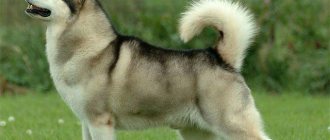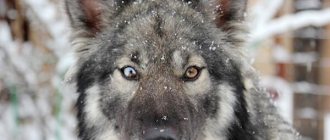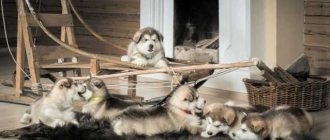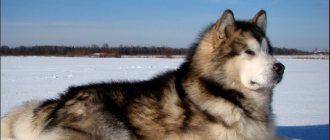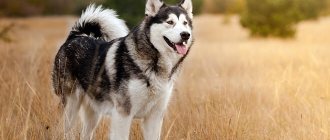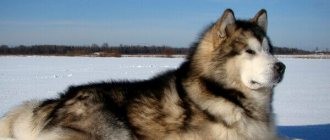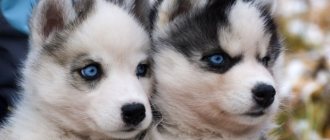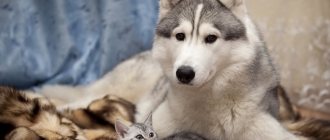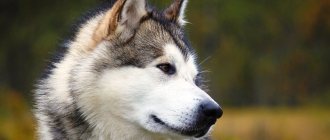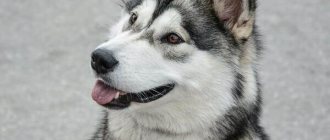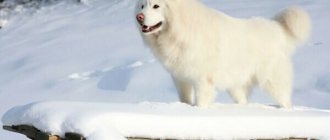Malamutes are large, muscular dogs with dense, thick fur and powerful paws that look like snowshoes. They were bred to do hard work. And behind their spectacular appearance lies a difficult character, which only an experienced and determined person can cope with.
When thinking about buying a puppy, you need to take this moment into account and find out everything about Malamutes in advance.
Brief history of origin
Malamutes are considered one of the oldest dogs on the planet. It is assumed that they have lived alongside humans since the Paleolithic era. This theory is confirmed by the remains of similar dogs found during archaeological excavations. Interestingly, they have a lot in common with modern representatives of the breed.
In 2004, geneticists conducted a DNA study, the results of which suggest that Malamutes are similar to wolves, Klee Kais and huskies.
Dogs arrived in North America about 14 thousand years ago. They wandered for a long time along with the ancient Eskimos, guarding human habitation and helping to hunt. The need to survive in harsh climates and with limited food made the dogs much stronger and more resilient.
Over the course of several centuries, the formation of the breed took place near the Anvik River, where the Malemute tribe, which migrated to Alaska from Siberia, settled. The ancient Eskimos had their own idea of what dogs should be like. Representatives of the tribe valued animals not for external attractiveness, but for strength, resistance to frost, hunting qualities and the ability to transport heavy loads.
Malamutes appeared in Europe only in the second half of the 19th century.
The subsequent popularization of the breed was facilitated by the “gold rush”, thanks to which in 1896 everyone dreaming of wealth began to gather in the Klondike. Since it was very difficult to move through the snowy northern expanses, people felt an urgent need for Malamutes. Because of this, the price of sled dogs instantly jumped up. For one Malamute you had to pay 500 dollars, and the team cost 1500.
To avoid paying so much money, gold miners began to bring St. Bernards and Newfoundlands with them and tried to mate them with local dogs. But the puppies from such matings had a beautiful appearance and a quarrelsome, aggressive disposition. In addition, in terms of strength and endurance, they were inferior to Malamutes and were not suitable for riding work. Therefore, the experiments had to be stopped.
To improve the speed characteristics of the breed and its ability to adapt to different climates, Malamutes began to be crossed with small dogs. Because of this, sled dogs are in serious danger of extinction. The disaster was averted only thanks to the efforts of enthusiastic breeders who managed to restore the breed. Over the next two decades, the breed was divided into 3 varieties - Kotzebue, M'Loot and Hinvan-Irwin.
With the outbreak of World War II, the Malamute population began to rapidly decline, and by 1947 there were only 30 registered dogs in the population. To restore the breed, breeders had to deviate from generally accepted standards.
Today, the Malamute is considered one of the most popular dogs and is officially recognized as the symbol of Alaska.
Health problems
Like all breeds, the Malamute can fall victim to some hereditary problems if poorly bred. Find a reputable breeder who can show you genetic testing results and can introduce you to happy clients who have had no problems with their puppies.
Diet and exercise are essential to keeping the breed healthy and long-lived, so don't overfeed or become a victim of your Malamute's begging for extra treats!
Interesting Facts
Throughout the history of the existence of Malamute dogs, a lot of interesting things have happened to them:
- These dogs specialize in transporting heavy loads. In a harness they are able to drag a load weighing up to 1500 kg.
- In 1984, the American Postal Service issued AKC stamps featuring four purebred dogs, including Malamutes.
- Dogs of this breed hardly bark. Alaskan Malamutes make wolf-like howls.
- Representatives of the breed often appear on movie screens. Malamutes starred in such films as “The Last Trapper”, “Iron Will” and “White Captivity”.
Photo
The photo shows what an adult Alaskan dog looks like in different colors, including white.
Breed description, standards, appearance
The Alaskan Malamute is a powerful, proportionally built, compact dog with strong bones and developed muscles. The first breed standard was approved in 1935 and was adjusted several times. Today, a dog’s appearance is assessed according to the 1999 edition of the document.
According to him, a malamute looks like this:
- The head is wide, proportional, with a rounded skull, large muzzle, flat cheekbones and a prominent stop. The jaws are powerful, with a full set of strong teeth that meet in a scissor bite. The lips are thin and tightly fitting. The nose is large, with wide nostrils and a black nose. A red Alaskan Malamute may have a brown nose.
- The eyes are medium-sized, almond-shaped, slanted. The iris is brown.
- The ears are medium-sized, erect, triangular, with rounded tips. When alert, turned to the sides. In the process of work they are laid back.
- The body is compact, with strong bones, a strong, moderately arched neck, deep chest and developed loin.
- The limbs are massive and muscular. Paws with thick pads and curved, tightly closed toes. The interdigital space is abundantly overgrown with hair.
- The tail is a continuation of the top line, rises above the back without touching it and curls into a ring.
The breed standard also contains a list of defects, the presence of which will disqualify the dog. This list included:
- Blue eyes;
- not black color of the nose;
- polydactyly;
- cryptorchidism.
Size and constitution
The Alaskan Malamute dog breed belongs to the large category. Its representatives have a strong skeleton and moderate sexual dimorphism.
| Weight, kg | Height, cm | |
| Female | 30-34 | 58-62 |
| Male | 33-38 | 62-66 |
Color and coat type
The Alaskan Malamute has a double coat, which consists of a hard outer coat and a soft, dense down. The length of the spine differs in different parts of the dog’s body. The neck, shoulders, croup, tail and hips of the Malamute are covered with longer hair. Short fur grows on the dog's head, face and paws.
The Alaskan Malamute standard provides for a coat color, which eliminates the presence of unevenly spaced spots. It allows for the existence of several color options:
- solid white;
- black and white;
- gray with white;
- sable with white;
- silver with white;
- red with white;
- blue with white.
On a note. A poorly defined cream mask is acceptable on the face of a white Malamute.
Health and life expectancy
Alaskan Malamutes, like other large breeds, are not long-lived. On average, these dogs live 10-12 years.
Since the formation of the breed occurred under the influence of strict natural selection, Alaskan Malamutes have good health and good heredity. But they also get sick sometimes.
The breed has a predisposition to the following pathologies:
- hip dysplasia;
- adenocarcinoma of the anus;
- atopic dermatitis;
- retinal atrophy;
- polyneuropathy;
- hemophilia;
- hypothyroidism;
- demodicosis;
- cataract;
- glaucoma;
- diabetes.
NECK, BACK LINE, BODY
The Malamute's neck is strong and moderately arched. The chest is well developed. The body is compact in structure, but not short coupled. The back is straight, slightly sloping towards the hips. The loin is strong and muscular. A long loin can weaken the back and is a disadvantage.
The Malamute's neck should be deep and muscular.
The Malamute's neck should be deep and muscular. It should have a nice curve when viewed from the side and flow smoothly into the shoulders and back. An insufficient angle of the shoulder joint is often the reason that a dog does not have a well-defined neck.
The Malamute's chest is wide and deep. A well-formed chest will not be hollow, narrow or with the elbows close together. The chest should not be so wide that it displaces the elbows and prevents the front legs from reaching properly when moving. The Malamute should not have a barrel-shaped or laterally flat chest, but the chest should be able to expand to meet the oxygen requirement for endurance. The sternum should not be excessively prominent, but should be immediately felt when examining the dog.
Narrow stance, elbows close together, and Chest too wide, elbows out
The line of the back is strong, straight and has only a slight slope from the withers to the sacrum. The tilt should not be too sharp or excessive, which could negatively affect the power of propulsion from the hindquarters when moving. During movement, the line of the back should remain unchanged with no signs of weakness such as swaying of the body, bouncing, sagging or arching of the back. The curvature of the Malamute's tail often causes the hair to rise on the rump, which can give the appearance of a high rear in a dog with a regular topline. It is therefore very important that the judge checks the line of the back with his hands, rather than relying solely on a visual assessment.
Arched back, and Sagging back and long lower back
The standard speaks of a compact Malamute body, but not short coupled. A short lower back may interfere with proper long strides. The loin should be of sufficient length to allow economical movement, but not so long as to weaken the back.
Correct placement and carriage of the tail
The tail is moderately set and continues the line of the back at the base. If the dog is not working, she carries it over her back. The tail should not hang significantly below the line of the back or curl into a tight ring on the back, and it should not be short-haired like a fox's tail. The tail should be well feathered and give the appearance of a waving plume.
Tail hanging to the side, too short and curled into a ring
The Malamute's tail, shaped like a billowing plume, is a distinctive characteristic of the breed. The tail continues the line of the spine, curling freely over the back. It should be well pubescent and of sufficient length to form a curving "fluttering plume". The tail should not curl into a ring, lie on the back or hang to the side significantly below the line of the back. When standing at rest, the Malamute usually hangs its tail down, and when working or moving, it pulls it back.
Character and behavior
Alaskan Malamutes are good-natured and sociable dogs. They do not show aggression towards strangers and are not suitable for the role of guards.
Energetic and sociable dogs have a complex character and are prone to dominance. Malamutes perceive their owner's family as a pack and may try to compete for leadership. And if they are not immediately shown who is boss, then problems will not be avoided in the future.
Stubborn Alaskan Malamutes do not tolerate rudeness and remember insults for a long time. If given the right opportunity, dogs will definitely take revenge.
Breed and other animals
Due to their tendency to dominate, Alaskan Malamutes do not get along well with dogs of the same sex, but get along well with members of the opposite sex. They also hardly tolerate the presence of small rodents and cats.
Breed and children
Despite their natural good nature, the Alaskan Malamute is not the best choice for families with young children. An energetic and heavy dog can inadvertently frighten or injure the baby. But for teenagers, the Malamute will be an excellent friend and playmate.
Owner reviews
The Alaskan Malamute is a breed for those who want a strong and kind friend and companion. Although it should be noted that considerable experience is required in raising a dog of this breed. According to many inexperienced owners, the Alaskan Malamute is practically impossible to train, so such a dog cannot be called smart. According to experts, this dog is quite smart and is able to correctly assess the current situation.
In order for a Malamute to begin to learn and carry out all the necessary commands, the dog must have a certain motivation. Anyone who has worked with this dog knows how stubborn a Malamute can be.
In this case, a person must show purposefulness and perseverance, but only within reasonable limits. If you overdo it, a proud and wayward dog may become offended.
Many owners note that this dog is quite smart and kind, so it can easily become a true and devoted friend.
Nowadays you can find a sufficient number of breeds that are similar to this breed. Naturally, they do not meet breed standards, although they look quite attractive. It is better not to have such dogs, since they are associated with uncontrolled and disorderly crossing, which leads to disturbances in the functioning of the immune system and to a general deterioration in health. The most important thing is to always remember that a dog is not a toy, big or small, but a living creature to whom you need to give some of your affection, care and love.
How to choose a pet
When buying a dog from someone else, there is always a risk of becoming the owner of a sick or non-purebred animal. To avoid such surprises, it is advisable to purchase Alaskan Malamute puppies from registered nurseries or from trusted breeders who value their reputation. When choosing, you need to pay attention:
- for the presence of documents and stamps;
- the conditions in which children are kept;
- behavioral characteristics;
- health status.
Important! The number of the brand on the puppy's belly or ear must match what is written in the birth certificate.
An important role in choosing a puppy is played by its appearance. It must comply as closely as possible with the current standard and be free from serious defects. Pedigree Malamute puppies have:
- dark eyes;
- smooth, thick paws;
- fluffy wool;
- thick tail;
- standard color.
Ideal home environment
The Malamute is great for anyone who leads an active lifestyle and is ready for consistent and diligent training. Although he loves people, he can be irritable around other dogs, cats or livestock. Early socialization is key to avoiding problems in adulthood.
Malamutes are known for being excellent family dogs and good with children, but like all dogs, it is important to socialize with children early. It is also important to teach children how to properly interact with their pet.
The ideal Malamute owner will be prepared for his stubbornness and keen intelligence. It is important to remember that a Malamute needs an owner that he respects, otherwise he will run the house and that will never be good for everyone.
An ideal home will have a place where the malamute can roam freely and the yard will be securely fenced to prevent the malamute from escaping. As long as you and your family are prepared for an active dog with high energy, the Malamute will be a pleasant and affectionate addition to your family.
Puppy care
A Malamute puppy leaves the breeder fully adapted to independent living. Therefore, he is simply allowed to explore new possessions and shown where his bowls and bed are located. And to make it easier for the baby to bear the separation from his mother, some thing with the smell of his native “nest” is placed in his place.
Important! To prevent the curious Malamute puppy from being injured, all wires, poisonous plants, medicines and household chemicals are removed from the house even before his arrival. And so that the little mischief does not spoil anything, valuable and fragile objects are hidden from him.
So that you can safely walk with an Alaskan Malamute puppy, it is subjected to preventive vaccination. This will protect it:
- from parainfluenza;
- leptospirosis;
- plague;
- rabies;
- parvo and coronavirus enteritis.
The first vaccination is given to the puppy at 8-9 weeks and repeated after 21 days. Before vaccination, he is given anthelmintic drugs, the dosage of which is calculated exactly according to the pet’s weight.
Antihelminthic treatment is carried out twice with an interval of 10-14 days.
Puppy weight and sizes from 1 to 12 months
The table shows how a Malamute puppy's size changes as it grows.
| Malamute puppy age | Weight | Height |
| 1 month | 4.5-5 kg | 28-30 cm |
| 2 months | 12 kg | 32-35 cm |
| 3 months | 18 kg | 38-46 cm |
| 4 months | 19-22 kg | 41-52 cm |
| 5 months | 23-25 kg | 45-56 cm |
| 6 months | 25-26 kg | 48-58 cm |
| 7-8 months | 26-34 kg | 50-59 cm |
| 9-11 months | 28-35 kg | 52-60 cm |
| 12 months | 28-36 kg | 54-63 kg |
Care and maintenance
The Alaskan Malamute is more accustomed to Spartan conditions. The dog is uncomfortable in the apartment, but on the street he feels in his element. True, the Alaskan Malamute has a habit of digging, so it should not be allowed out of the enclosure unattended. Otherwise, a large and energetic dog will turn the owner’s flowerbed into a huge hole in a matter of minutes.
Important! When kept in an apartment, the Alaskan Malamute sheds all year round, and due to the heating being on, the dog suffers from overheating and dermatological diseases.
Hygiene procedures
The Alaskan Malamute does not require complex and time-consuming grooming. For a dog to have a neat appearance, basic hygiene is enough:
- The pet's ears are cleaned 2-3 times a week with a cotton swab dipped in a special product. They are also checked for heavy or foul-smelling discharge. If suspicious symptoms are detected, the dog is shown to the veterinarian.
- The eyes of the Alaskan Malamute are wiped daily with a cotton pad moistened with chamomile infusion. If increased dryness, redness, or excessive lacrimation is detected, the dog is scheduled for a consultation at the clinic.
- The Alaskan Malamute's nails usually wear down on their own. If necessary, they are shortened with a nail clipper.
- The Alaskan Malamute's teeth are brushed weekly with a silicone brush and a small amount of special toothpaste.
- The dog's fur is combed 3-4 times a week with a slicker brush or a wide-tooth comb. During the molting period, the procedure is carried out daily, and the usual tools are replaced with a furminator. The fur between the dog's toes is carefully trimmed as it grows. The Alaskan Malamute is bathed no more than 3-4 times a year. And after bathing procedures, the dog’s fur is thoroughly dried so that eczema does not form on the skin.
Feeding
The Alaskan Malamute needs a complete and well-balanced diet, enriched with animal proteins. It is advisable to feed him in a strictly designated place and on approximately the same schedule.
The routine should be drawn up depending on the age of the dog:
- younger than 8 weeks – 5-6 times a day;
- 2-6 months – 4 times a day;
- 6-12 months – 3 times a day;
- over 12 months – 2 times a day.
Industrial feed
This type of feeding is not typical for Alaskan Malamutes. But for their own reasons, many owners prefer to give their pets ready-made food. They are chosen depending on the dog’s age and level of physical activity. When purchasing industrial feed, it is important to look at the expiration dates and composition of the presented assortment.
High-quality super-premium drying should have a high protein content and a complete absence of soy, wheat, dyes and corn.
Alaskan Malamutes eagerly eat the following brands of food:
- Gemon;
- Bosch;
- Pronature;
- Arden Grange.
Natural feeding
With this type of nutrition, the diet of the Alaskan Malamute should be dominated by fresh meat, which is kept in the freezer for several days and scalded with boiling water. It can be beef, lamb, rabbit, turkey or chicken. But meat alone is not enough for a dog to receive all the nutrients. Therefore, the following is additionally introduced into the diet of the Alaskan Malamute:
- cereals;
- vegetables;
- offal;
- sea fish;
- chicken eggs;
- dairy products.
In order not to harm the dog, the following are completely excluded from its menu:
- onion;
- mushrooms;
- pork;
- chicken bones;
- confectionery;
- any food from the master's table.
Walking and exercise
Alaskan Malamutes are energetic sled dogs and require hours of exercise every day. Moreover, they will not be satisfied with sedate walking next to the owner. To maintain muscle tone, Alaskan Malamutes need full exercise in the form of jogging or cycling. If the Alaskan Malamute is deprived of the opportunity to splash out his energy, he begins to feel sad. To have fun, a dog can howl for a long time, make digs and damage property.
Important! The Alaskan Malamute is a large dog that can only be held by a physically strong person. Therefore, dog walking cannot be delegated to teenagers and fragile girls.
Training and education
Due to the innate stubbornness and tendency to dominate, you need to start training the Alaskan Malamute from the first days of his stay in the house. Until the puppy receives all vaccinations, he is trained at home. The first lessons should not last longer than 5-10 minutes. They are carried out in a calm atmosphere according to the principle “from simple to complex.”
After the end of quarantine, the Alaskan Malamute begins to be accustomed to the street. At first, they walk with him in quiet, secluded places. When the puppy stops being afraid, they begin to introduce him to busy streets and teach him to calmly deal with various irritants such as people, strange animals and transport.
By the age of six months, the Alaskan Malamute should:
- unconditionally run up at the first call;
- walk calmly on a leash;
- do not take food from the ground or from the hands of strangers;
- follow the commands “Sit!”, “Place!”, “Stand!” and “Lie down!”
Important! It is better to train an Alaskan Malamute under the guidance of a professional. After all, it is much easier to raise a puppy without bad habits than to later correct the mistakes of an inexperienced trainer.
Upbringing
A Malamute puppy is a very sociable and active baby, so it needs to be raised from childhood. Once you have him, you can train him to toilet and call him. In addition, you can immediately begin training, taking into account the age of the puppy. You should start with the simplest commands. If you don’t start teaching your dog commands from a young age, he won’t feel his master in you and will try to gain power over you.
Why does it howl and how to wean it off?
The Alaskan Malamute is a rather emotional animal that needs communication. Therefore, there are several reasons why a puppy may howl:
- is very sad and bored;
- rejoices at the long-awaited meeting with the owner;
- very scared, experiencing a lot of stress.
It is better not to stress the puppy, as this may affect the results of training. To prevent your pet from getting bored, leave him plenty of toys and entertainment during your absence.
Why does he dig the ground?
The constant desire to dig a deeper hole somewhere is associated with genes : your pet’s ancestors had to get food in this way. It is unlikely that anything can be done with what has been formed for many years, so it is better to accept it and let the Malamute dig holes for pleasure. Remember to ensure that this does not cause harm to your area.
How to properly train to stand?
Before teaching a puppy to stand, it is better not to feed it for 4-5 hours so that it responds well to the treat. At the beginning of training, let the puppy play and run around so that the Malamute is in a good mood and the command causes a positive reaction.
- Take a piece of treat, stand in front of the puppy, and start swaying from side to side, passing the treat in front of the dog's nose. Then she will also need to balance.
- When the hind legs are in a stable position, begin to move left and right, this will help the puppy stand firmly on his front legs.
- Having given him a treat at this moment, confidently say the command: “Stand!”
- Give the next piece, making a large circle with your hand so that the dog freezes and repeat the command. Gradually, the Malamute will learn to perform it well.
Pros and cons of the breed
Although the breed is popular among ordinary dog breeders, it has not only advantages, but also disadvantages. And it’s better to get acquainted with them before making a final decision on purchasing an Alaskan Malamute.
| pros | Minuses |
| Pretty appearance | Tendency to dominate |
| Friendly disposition | Unsuitability for apartment living |
| Endurance | Need for long walks |
Dimensions (height at withers, etc.) and what it looks like in the photo
For a boy of this breed, the height can be from 60 to 63 cm, and for a girl - from 57 to 59 cm. According to American standards, the ideal height for a male is 63.5 cm, and for a female - 58.5 cm.
According to the breed standard, the body length of a Malamute should be rectangular, tending to square, so for a male it is on average 63-64 cm, and for females - 58-59 cm.
Expert opinion
Kozhevin Semyon Kirillovich
Expert dog handler.
“The height of a Malamute must be in the correct proportion to its weight. After all, only in this case will the dog not only look harmoniously built, but also be able to fully demonstrate its working qualities. A Malamute in good condition is fast, tireless, hardy and strong enough to carry heavy loads. However, the owners of these dogs need to take into account that, like most sled breeds, Malamutes are voracious, and therefore, no matter how hungry the pet’s eyes may look, you cannot feed it in between feedings.”
Malamute price
The cost of an Alaskan Malamute puppy depends on the availability of documents, exhibition prospects, the eminence of the ancestors and the reputation of the kennel.
- A dog without a pedigree costs between 5-10 thousand rubles.
- A puppy with documents, but without any relationship with the champions, is estimated at 20-40 thousand rubles.
- An Alaskan Malamute from titled parents with the prospect of a show career costs 70-120 thousand rubles.
Alaskan Malamutes are large, showy dogs with a friendly but stubborn personality. Hardy and strong dogs will become faithful companions to those who are willing to spend time on long walks together.
Useful video
From the video you will learn everything about the Malamute dog breed:
Loading…
The Malamute was created to race the north wind across the frozen lakes of Alaska.
But his unsurpassed qualities, such as friendliness, high intelligence and spectacular appearance, helped this initially working dog win exhibition pedestals and win the hearts of many people living in all corners of the Earth.
MOVEMENTS
The Malamute's movements are smooth, balanced and powerful. He is quite agile for his size and build.
Correct movements – the Malamute often moves with its tail extended back
The Malamute is a dog that works on the move, often moving over steep, rough terrain, avoiding obstacles in its path and making sharp turns. Therefore, the reliability and endurance of the Malamute's movements is a vital characteristic. His movements must demonstrate strength, and at the same time, agility and tirelessness.
When viewed from the front or rear, the limbs move strictly along the line
When viewed from the side, it is clear that the powerful hind limbs make a strong push, which is transmitted through the muscular lower back to the front ones. The forelimbs receive impulse from the hind limbs and take a smooth, wide step forward. When viewed from the front or rear, the limbs move strictly along a line, neither too close nor too wide apart. When moving at a fast trot, the paws will move closer to the center line located under the body.
The Malamute should move in smooth, long strides with a strong push from the hind legs, the force of which must be transmitted through the lower back to the front legs. This breed is not designed to trot like herding breeds. Straightening of the limbs should be moderate and smooth, without high lifting, slapping with paws or other senselessly wasting energy. Thrusting out the limbs may be impressive to spectators, but it is a wasted and ineffective movement.
The head and neck should be extended forward and the back should remain strong and not arch, sag or rock to maintain a straight line and transmit power during movement. As discussed in the sections on forelimbs and hindlimbs, the forelimbs and hindlimbs should move exactly in the same line, moving closer to the center line as speed increases. If the Malamute's front and hind legs meet the standard requirements, he will not exhibit crab-like movements, excessively extend his limbs upward, exhibit overlapping or intertwining of limbs, or other movement errors.
Movement is the most important factor
Stilted gait or any other type of movement that is not sufficiently productive and/or tireless must be penalized.
Poor angulation of the front and rear legs results in a shortened stride, forcing the dog to take more steps to cover the same distance relative to a properly built dog.
Movement is the most important factor influencing a dog's score when judging the Alaskan Malamute breed. Any deviations from absolutely correct, effortless and effective movements should be seriously penalized.
